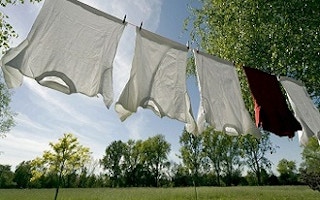If you’re worried about dressing ethically, chances are you think about sweatshop conditions in developing countries, unsustainable farming practices, convoluted global supply chains that ring up a huge carbon footprint, and mountains of fast-fashion festering in landfill.
But the first thing you should think about is how often you wash your clothes. It turns out that when you look at the whole life cycle of a piece of clothing, everyday washing and drying damages our natural environment the most.
It’s all in the wash
Life cycle analyses are tools that show environmental impacts of various products. They measure effects like greenhouse gas emissions, energy consumption, water use, and pollution. For clothing, they generally measure the impact of growing fibres, garment production, packaging and transporting to stores, customer use, and finally disposal.
Doing this allows us to compare environmental impacts of apples and oranges. Polyester, for example, requires a lot of energy to make, little to wash and dry, but takes a long time to biodegrade. Cotton, on the other hand, requires vast amounts of water, fertilisers and pesticides to grow, needs more water to wash and more energy to dry but is relatively low-impact to dispose of.
When we look at clothing overall, we consistently find the greatest environmental impact of a garment over its entire life is not in its production, transport or disposal, but in its use by the consumer – washing, drying and ironing.
A recent study of Chesty Bonds show up to 80% of their energy consumption happens during customer use. With Levi Jeans, nearly 60% of the environmental impacts come from washing.
This is fairly normal according to Kate Fletcher, who in her 2008 book Sustainable Fashion and Textiles: Design Journeys looked at the environmental impact of the fashion industry and reported that up to 82% of its energy use, 66% of its solid waste and over half of its emissions to air come from washing and drying clothes.
Why do we wash so much?
Our standards of cleanliness have only developed over the last 200 years. Before that weekly, monthly or even yearly baths were pretty normal. Clothes were rarely removed let alone washed. Georges Vigarello’s Concepts of Cleanliness tells the story of a French King Louis being surgically removed from a vest he had been wearing for four years.
This does not sound particularly hygienic; we know about germ theory and the importance of keeping clean in controlling disease. But once we’re clean enough to stay healthy, escalating cleanliness doesn’t really benefit us.
Our preoccupation with cleanliness is due partly to technological developments – it’s ridiculously easy to launder clothes these days. But a bigger influence is a change in social conventions. Marketers peddling cleanliness products like laundry powder sell us elevated cleanliness ideals to increase their business opportunities.
In 2003 the average American household did 392 loads of washing. With an American population of 314 million this is obviously an attractive market. In developing countries burgeoning middles classes have access to more washing facilities; this creates a huge new market where washing companies can promote increased cleanliness. But these new norms require huge amounts of water, energy and chemicals to satisfy.
What if we wash less?
I wanted to know what would happen if we washed our clothes less, so I recruited 30 participants to wear the same pair of jeans for at least five days a week for three-months without washing them. I raised the bar by wearing my jeans every day of the three months except one.
“
This is fairly normal according to Kate Fletcher, who in her 2008 book Sustainable Fashion and Textiles: Design Journeys looked at the environmental impact of the fashion industry and reported that up to 82% of its energy use, 66% of its solid waste and over half of its emissions to air come from washing and drying clothes.
We experienced first-hand that the jeans did not become socially challenging: they weren’t visibly dirty and they didn’t get smelly.
Leonie: “I’ve started to wear T-shirts for a couple of days in a row and no one’s noticed that either.”
We also became more aware of how subtle social pressures shape our everyday lives and the decisions we make about cleanliness.
Matt: “You’re not rude to people verbally, in the same way I don’t like the thought my presence would be rude or offensive to other people.”
This made me think about how arbitrary social standards lock us into routine consumption, and how we cruise through life barely aware of the resources concealed in our autopilot actions.
Many of us want to live more sustainably, but our water and energy intensive lifestyles have a huge amount of momentum that it takes a serious intervention to become aware of, let alone shift.
We need to recode cleanliness standards, based on reality and pragmatism not concepts pushed by marketing: collective conventions that help us navigate everyday life sustainably and hassle free.
This article is based on a peer-reviewed paper published in the Journal of Consumer Culture. Tullia Jack is a PhD student at RMIT University.










